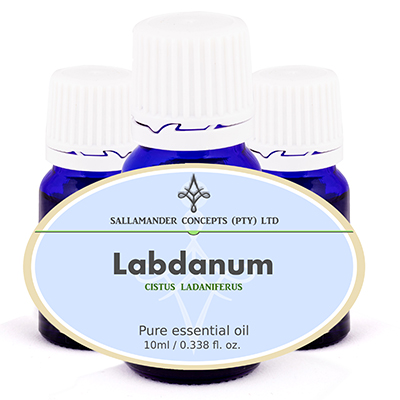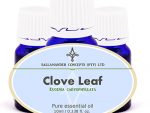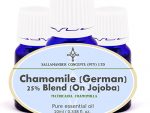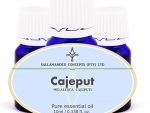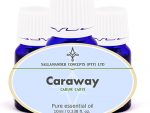Information on Labdanum essential oil
Labdanum essential oil is extracted from Cistus ladaniferus of the Cistaceae family and is also known as Rock Rose, Cistus and Rose of Sharon.
Labdanum has a wonderfully soothing, deep fragrance, useful in treating people after shock or trauma has been experienced.
Labdanum essential oil, also known as Cistus oil, is of great benefit when included in a lymph massage blend, also when applied to the shoulders and neck to drain swollen lymph nodes in the neck and for menstrual aches and pains and stomach cramps.
Rock Rose essential oil (Labdanum) has been known since ancient times to give a sense of warmth and comfort and to be good for the soul.
Oil Properties of Labdanum essential oil
Labdanum essential oil has a sweet, warm, almost musky herbal scent and is yellow in colour.
Uses
Labdanum has been used in salves and ointments since the middle ages. The gum was used to treat catarrh, dysentry and to encourage the menses.
Much confusion ranges regarding the oil extracted from cistus ladaniferus. It seems to have many names: labdanum, rock rose, cistus and rose of sharon.
Labdanum is sometimes called Rock Rose, which is sometimes thought to be the floral extraction of Helianthemum canadense – which is very costly.
Cistus can also refer to the steam distillation of the leaves and twigs of cistus ladaniferus or to the oil produced from the leaves and flowers, sometimes through the enfleurage process, which would make the oil very expensive.
Rose of Sharon is used to refer to Labdanum essential oil.
The flower referred to in the King James version of the bible, Song of Solomon 2:9: “I am the rose of Sharon, the lily of the valley” was translated in later editions to mean “I am the flower of the field”.
The actual flower that the poet was referring to is not known, although Hibiscus syriacus is commonly known as ‘Rose of Sharon’ in the USA.
Extraction of Labdanum essential oil
Our Labdanum is extracted by steam distillation of the crude gum.
Therapeutic Properties
The therapeutic properties of labdanum are tonic, antimicrobial, emmenagogue, astringent and antiseptic.
Chemical composition
The main chemical components are Camphene, sabinene, myrcene, phellandrene, limonene, cineole, borneol, cymene, nerol, fenchone and geraniol amongst others.
Precautions
It is classed as a non-toxic, non-irritant but should be avoided during pregnancy or when wanting to become pregnant, as it encourages menstruation.
Uses
Labdanum essential oil is mostly used in massages for lymph drainage and in inhalation therapy to calm and ease the mind after deep trauma or sexual assault – where there is no wish to avoid the properties in the oil that may bring on menstruation.
Labdanum is excellent for treating swollen nodes in the neck (through the application of a warm compress), for stomach problems caused by the cold and for chronic skin conditions, such as psoriasis and eczema and to aid the healing of wounds in diabetes, or any slow healing wound for that matter.
Burners and vaporizers
In vapor therapy Labdanum can be helpful with combating symptoms of shock, numbness and cold experienced after deep trauma or sexual assault.
Blended Massage Oil and in the Bath
As a blended massage oil or diluted in the bath, Labdanum essential oil will assist with lymph drainage, swollen lymph nodes, stomach problems caused by exposure, cystitis, menstrual cramps, slow healing skin ailments, psoriasis, eczema and diabetic wounds.
Blended in Cream
In a cream or lotion it is used to treat inflamed or infected skin conditions, slow healing wounds, swollen lymph nodes and to aid with lymph drainage.
Blends
Although most essential oils blend well together, Labdanum oil blends particularly well with Bergamot, clary sage, chamomile, cypress, helichrysum, juniper, orange patchouli, pine, sandalwood and vetiver essential oils.

